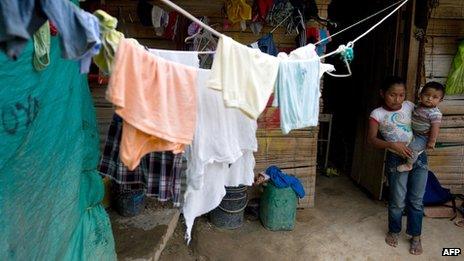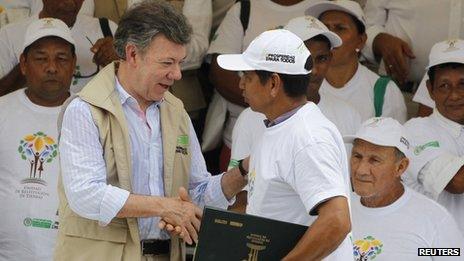Colombia tops IDMC internally displaced people list
- Published

Indigenous Colombians are among those internally displaced by the violence in the Andean country
Almost 29 million people lived in internal displacement in 2012, with 6.5 million newly displaced just in the past year, a report by the Norwegian Refugee Council suggests.
For the fourth year running, Colombia has the highest number of internally displaced people on the list.
Globally, the total number of displaced people has risen, with the conflict in Syria blamed for much of the spike.
A third of all internally displaced are in sub-Saharan Africa, the report says.
The annual report, external by the Norwegian Refugee Council's Internal Displacement Monitoring Centre (IDMC) suggests internal displacement - in which people flee from violence without crossing their country's borders - will continue to accelerate unless permanent solutions to conflicts are found.
IDMC Director Kate Halff says that governments are "responsible for finding long-term solutions for their displaced citizens".
The report says that Colombia, with its estimated 4.9 to 5.5 million internally displaced people tops the global list.
It estimates that Colombia's internal armed conflict forced around 230,000 people to flee their homes in 2012.
'No recognition'
However, the report says that the figure is provisional, as the government did not publish official figures for the past year.
It also notes that the figure fails to include those people displaced as a result of violence carried out by criminal and drug-trafficking gangs.
That violence, however, has been on the up, with Colombian President Juan Manuel Santos recognising the rise of the criminal gangs as one of the main threats facing the country.

Colombian President Juan Manuel Santos has launched a programme which restores land to those displaced by violence
On Sunday, police figures suggested that Colombia's largest criminal gang, Los Urabenos, now has more members than the left-wing rebel group, the National Liberation Army (ELN).
Both the Colombian Red Cross and the IDMC have warned that the victims of criminal gangs in Colombia do not receive the same official recognition as those victimised by the Farc or ELN rebel groups.
Police say the Urabenos have more than 2,000 members and operate in major cities such as Medellin, as well as rural areas, where they engage in drug and arms trafficking and extortion.
Colombia has suffered from almost five decades of civil conflict with both left-wing guerrilla groups and right-wing paramilitaries fighting each other, and the security forces.
Negotiators representing the government and the Farc rebel group are currently holding peace negotiations in Cuba in an attempt to end the conflict.
The government has also launched a restitution programme aimed at returning land stolen as part of the conflict to its rightful owners.
- Published5 April 2013
- Published4 March 2013
- Published18 September 2010